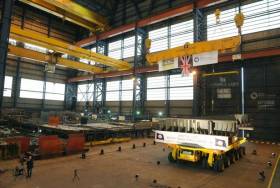Displaying items by tag: Cammel Laird shipyard
#Shipbuilder - UK shipbuilder Cammell Laird saw profits and sales fall last year – but the shipyard on Merseyside which Afloat has noted is where Irish Ferries flagship Ulysses awaits drydocking, remains upbeat that it will win more new contracts.
As the Liverpool Echo writes the Birkenhead company reported turnover for the year to March 2016 of £99m – down from £115m in 2015 – thanks to an expected lull in military work.
Pre-tax profits fell by three quarters to £2.5m, down from £10m, accounts filed at Companies House show. But the group is hopeful it will win more military contracts and more work in the renewable energy and offshore wind power sector.
Cammell Laird had warned last year that it expected turnover to fall as there was a pause in military work.
In 2013 it signed a five-year contract extension to maintain nine Royal Fleet Auxiliary (RFA) vessels.
During the year it completed refits of the Royal Fleet Auxiliary’s vessels Wave Knight, Black Rover, Fort Austin, Wave Ruler and Fort Rosalie. The latter replenishment stores supply ship Afloat adds is berthed in the facility's wet basin. Ulysses is also berthed here having completed a Dublin-Holyhead sailing then continued to Merseyside to arrive on Wednesday.
The yard also completed work on parts of the Prince of Wales aircraft carrier, and did work for BAE Systems on the Astute Submarine.
Cammell Laird also completed contracts with firms including Irish Ferries, P&O and the Isle of Man Steam Packet Company.
In November 2015, Cammell Laird won the contract to design and build the new polar research vessel the RRS Sir David Attenborough – the boat almost named Boaty McBoatface. The project secured more than 400 jobs at the yard and another 100 jobs with local suppliers.
Sir David visited the shipyard last October for the keel-laying ceremony.
The Merseyside newspaper has more to report on the shipyard's activities here.
Afloat adds that the yard also won a £6m contract to build a new carferry, Strangford II. The newbuild however during berthing trials last month on Strangford Lough as previously reported encountered vehicle ramp issues.
Steady Progress Takes Shape on New Strangford-Portaferry Ferry
#NewPortaFERRY -A newbuild for the Strangford-Portaferry service under construction at Cammel Laird, Birkenhead as previously reported on Afloat.ie is expected to deliver the 28 car / 260 passenger ferry in August this year.
According to Cammel Laird’s winter edition newsletter, the project is running on schedule with 75% of the vessel structurally complete. The yard facing opposite Liverpool’s famous waterfront on the Mersey, saw Northern Ireland Minister for Regional Development Michelle McIlveen view the progress on the newbuild Strangford Ferry which is to serve the lough route at the Narrows.
The Minister said: “It is really impressive to see the progress being made by Cammell Laird on the new ferry. The build is on schedule and I look forward to seeing the new vessel in operation by late summer 2016. This £6 million investment by the NI Executive will see the replacement of the existing MV Strangford, which is now over 40 years old. The new modern ferry has been designed specifically for this important route and will provide a more reliable and efficient ferry service for the public in the years ahead.”
The newbuild’s pipework and machinery is now being fitted, with all key equipment now on site and undergoing installation. This includes 2 Cummins engines, 2 Voith propulsion units, 2 Cummins generator sets, a Hamworthy Sewage Treatment Plant, and a full Desmi pump set.
A passenger Lounge, changing rooms, crew mess and wheelhouse have now been installed. There are currently 50 workers on the project, with over 20% of this number being made up by apprentices. A further 4 second year apprentices are expected to have joined the project in the new year to gain some invaluable new-build experience.
The newbuild met her ‘sister’, Portaferry II, for the first time in November when the vessel returned to the Mersey for her first dry docking in 14 years since being launched onto the Mersey.
Afloat, adds that this also took place on the Wirral Peninsula, when the newbuild was then completed at the nearby McTay Marine yard at Bromborough.
While the new ferry is a completely new design, many of the successful design features on the Portaferry II are reflected in it notably having the same car and passenger capacity. The two ferries will together run on the Strangford-Portaferry service operated by Transport NI.
Afloat also adds that taking place of Portaferry II's roster on the short estuary crossing is the reserve ferry, Strangford.
























































